I write for the Scribehound Countryside Channel, and I am passionate about connecting people to their environment and nature. However, this is my first article on the Gardening Channel. While nature restoration is finally looking at the bigger picture, think complete river catchments as an example; with an estimated 27 million people gardening in the UK, you all play an increasingly important role in bringing the countryside into the town.
You can dive headfirst into the intricate dance of plant-animal symbiosis, unravelling the mysteries that keep ecosystems ticking—but I’ll leave that to the professors and scientists among you. Me? I want to show you those beneficial, looser relationships where you can play and enjoy your part. Easy ways to connect with nature, and I will start with the common wild teasel Dipsacus Fullonum.
A weed,” you say. “Beware! “And yes, left to its own, it will happily invade your lawn. But let’s see it for the joy it brings. Like a foxglove, it sits quietly in its first year, a humble rosette of leaves, quietly, unassuming, just waiting. Then, in its second year, it rises—a wild, untamed beauty—its spiny, bright green stems stretching upwards to equally spiky egg-shaped mauve flowering bracts. The point at which not just its beauty but its generosity comes to light.
These tiny mauve flowers enrich your garden in clustered bands, enticing the bees and butterflies first before, later in the year, the twinkly, twittering flocks of goldfinches seek out the prickly seedheads.
Wrapped around the stem, the leaves form a verdant cup, collecting water, which seems to defy evaporation, perfectly pitched above the ground. Like all good ‘weeds,’ they are easy to grow, often referred to as a plant of ‘waste grounds,’ a desultory, demeaning term for both the habitat and the plant, once banished to the outer edges of cultivation. What they really like is disturbed soil, where the seeds can become established. They scatter themselves across your gravel pathways and flowerbeds, tolerating drought and dry conditions with their strong radiating root system. But before I scare you away, they are easy to pull out and readily take to transplanting in the right place. Across the garden, we have four clumps to bring in the goldfinches.
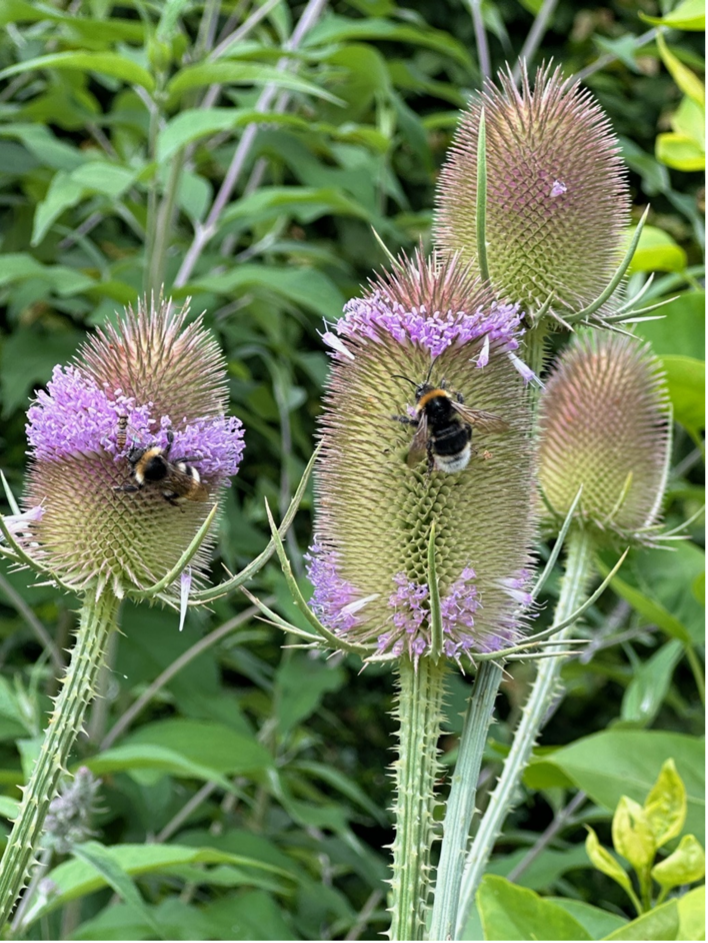
The flower on the left has recently opened, while the older flower in the middle has now progressed to the top and the bottom.
Easy-growing teasels will be home in most places, but they keep their nectar protected deep inside the flower. As a result, they have developed close relationships with long-tongued insects, especially bumble bees, moths, and butterflies.
Unusually, and unlike foxgloves, they flower from the centre of the flower head outward. Their unique blooming pattern starts with a ring of tiny flowers forming around the middle of the cylindrical flower head. Over time, the flowers gradually expand upward and downward, creating a distinctive two-tone appearance as different sections bloom at different stages.
Buff-tailed, White-tailed, Garden, and Red-tailed (Bombus) bumblebees, with their relatively long tongues, take advantage of the long flowering season and the sizeable conical landing pad where they forage alongside similarly, long-tongued butterflies, especially large whites, peacocks, brimstones, and red admirals,
These are tall plants, with the flowers typically held head height or higher, helping us to observe their many followers. We associate the soft yellow brimstone with Spring, along with primrose, daffodils, and dandelions. But here in late summer you get a second brood, a second chance to feast on the fresh buttery colours feeding intensely on the rich nectar to build up reserves for hibernation. We will not see them again, before they awaken on some mild February day next year, signalling Spring, long before the first swallow or, if you’re fortunate, the call of a cuckoo.
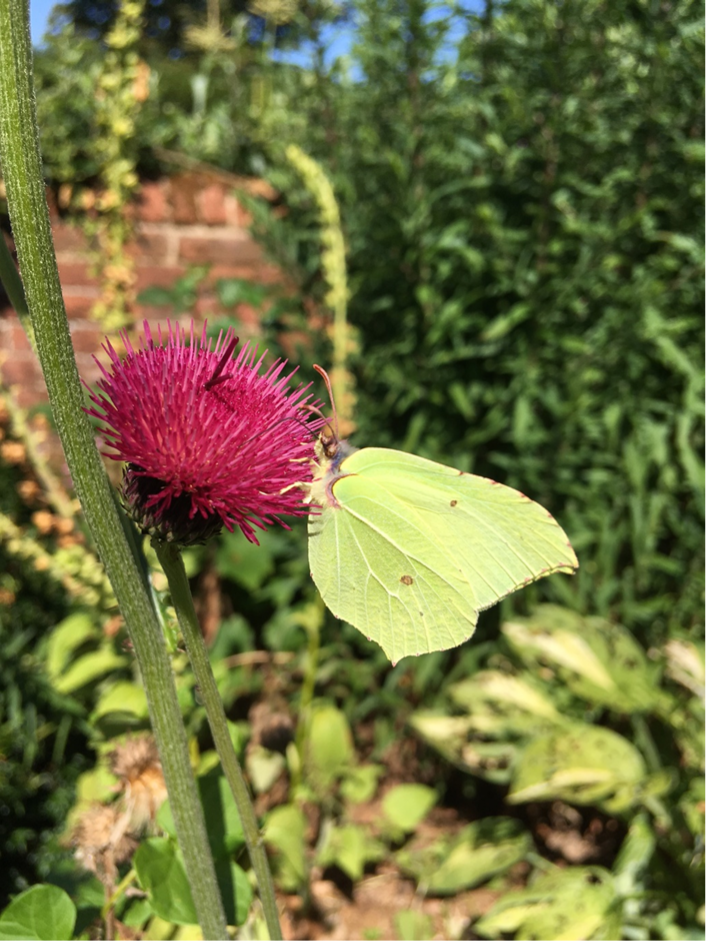
I could not find one of my pictures of brimstone on Teasel, so here is one on Cirsium rivulare Atropurpureum, which they equally enjoy. This is the male which usually flies a little earlier than the paler, light cream-coloured female.
No other bird shares a bond with a teasel like the goldfinch. With their long pointy beaks, they can reach the rich seeds buried deep in the now brown seedheads, which others would struggle to access. I believe these ‘buried’ seeds also keep the food available longer into the winter, although they are ripe by the end of September. Many of you reading will buy similar-sized ‘Niger’ seeds, which Goldfinch also love, but they will just as happily flock noisily to the rich fat and protein teasel seeds. Grow your own natural birdseed.
With an abundance of food all winter, our goldfinches hang around the garden all year round, always together in their cheerful way. For nests they choose the crook of a hazel, apple, lilac, or creeper around the house, at a favoured height of between ten and twenty feet, with multiple broods from April through to late August. This small flock or ‘charm’ (their collective name) building up to over twenty by late summer.
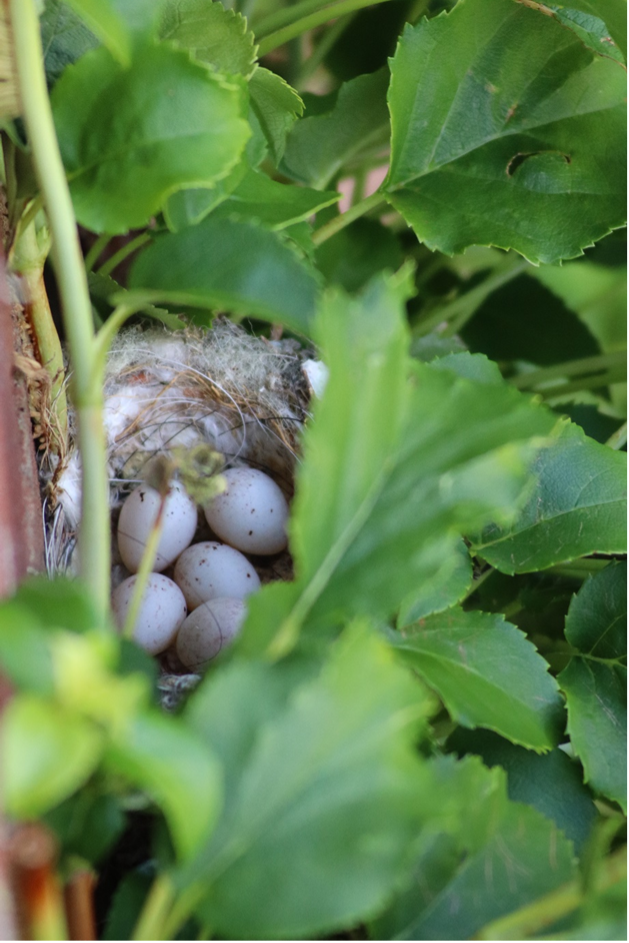
You can just make out the horsehair cradling these eggs
The nest shown is in a climbing hydrangea, although they also honeysuckle, conveniently constructed just below our bedroom window, with an unusual clutch of five eggs against the usual four. Since I spent my boyhood raiding birds’ nests, they have always mesmerised me. Goldfinches have one other plant relationship in the garden – Jerusalem Artichokes. They strip material from the stems, weaving it together with horsehair and wool from the fields, creating a strong structure for such a small bird. These carefully crafted nursery cups are still visible long after the leaves have fallen, deep into January, braving it against the winter winds, A distant summer memory.
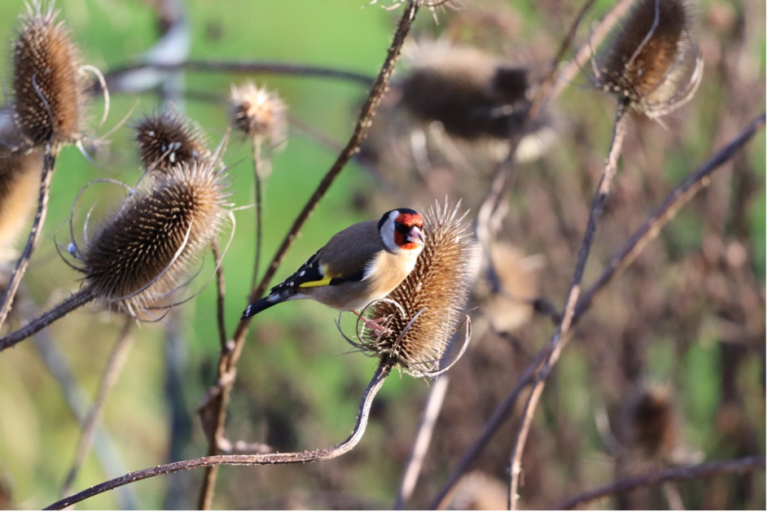
Grow your own goldfinch food.
I took the above photo last week when 12 birds were feeding together right outside my office window. They maintain a constant chatter, a friendly discourse, which no doubt helps them warn of impending danger. However, they are safer here from sparrowhawks and cats than feeding around the bird table. Which reminds me, as Winter approaches, keep your bird table tucked in close to cover. What you may lose in vision you make up with safer, more confident birds capable of fleeing predators.
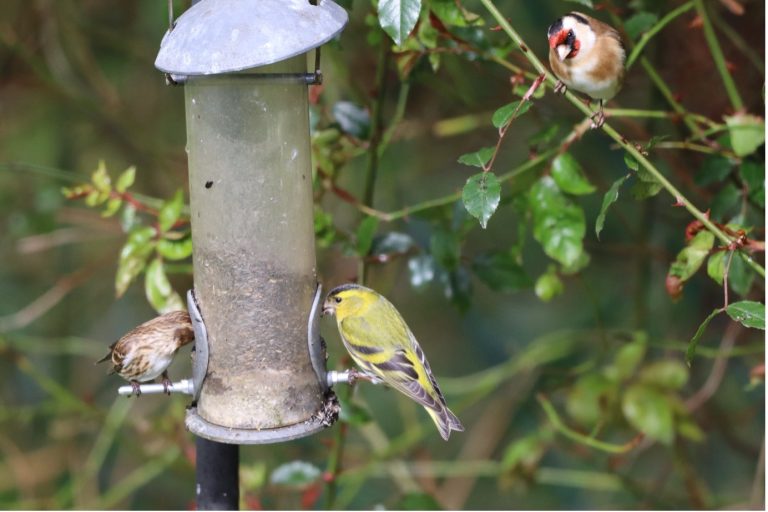
Or buy in a ready meal of Niger seed (siskin, redpoll & goldfinch)
So, there it is for the teasel.
For plant lovers, you have a special towering structure and these architectural seedheads in the winter. But for me, the joy is the bees when those light mauve bands of flowers first open in July with the promise of brimstones and goldfinches to come.